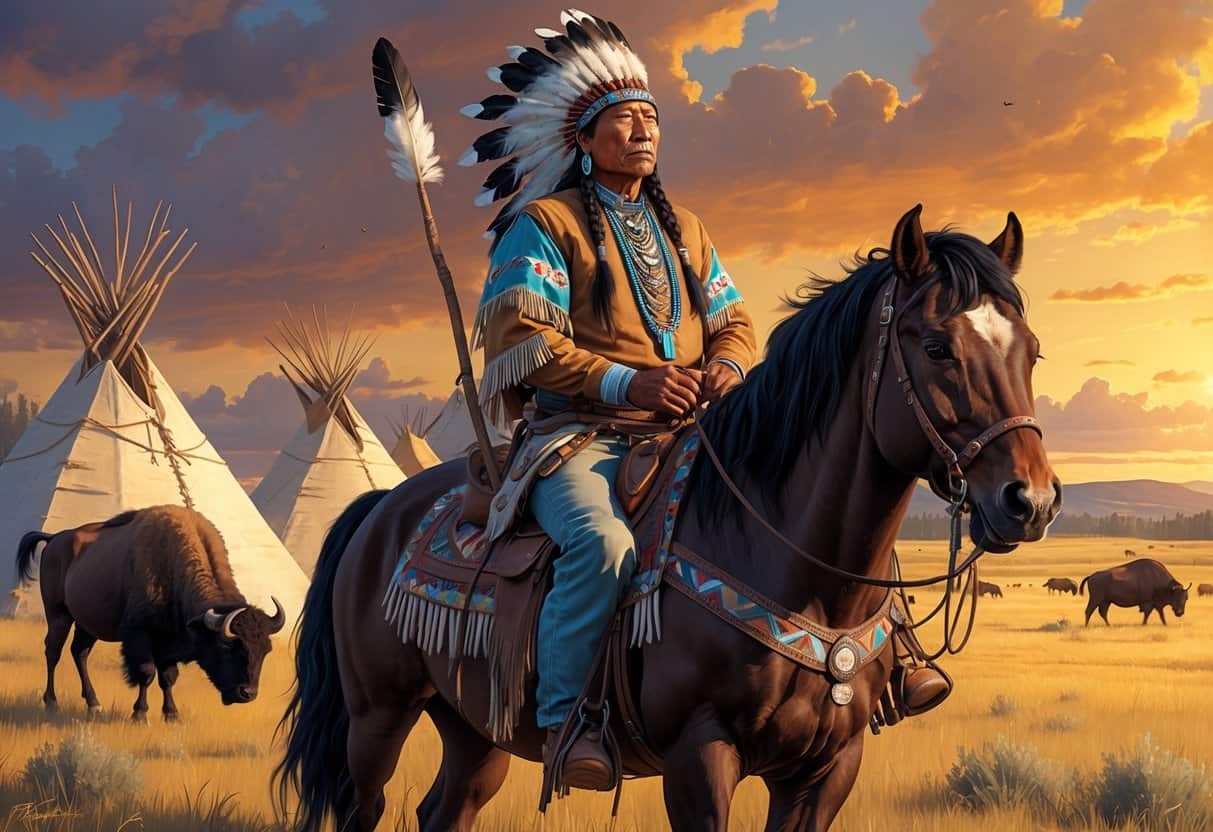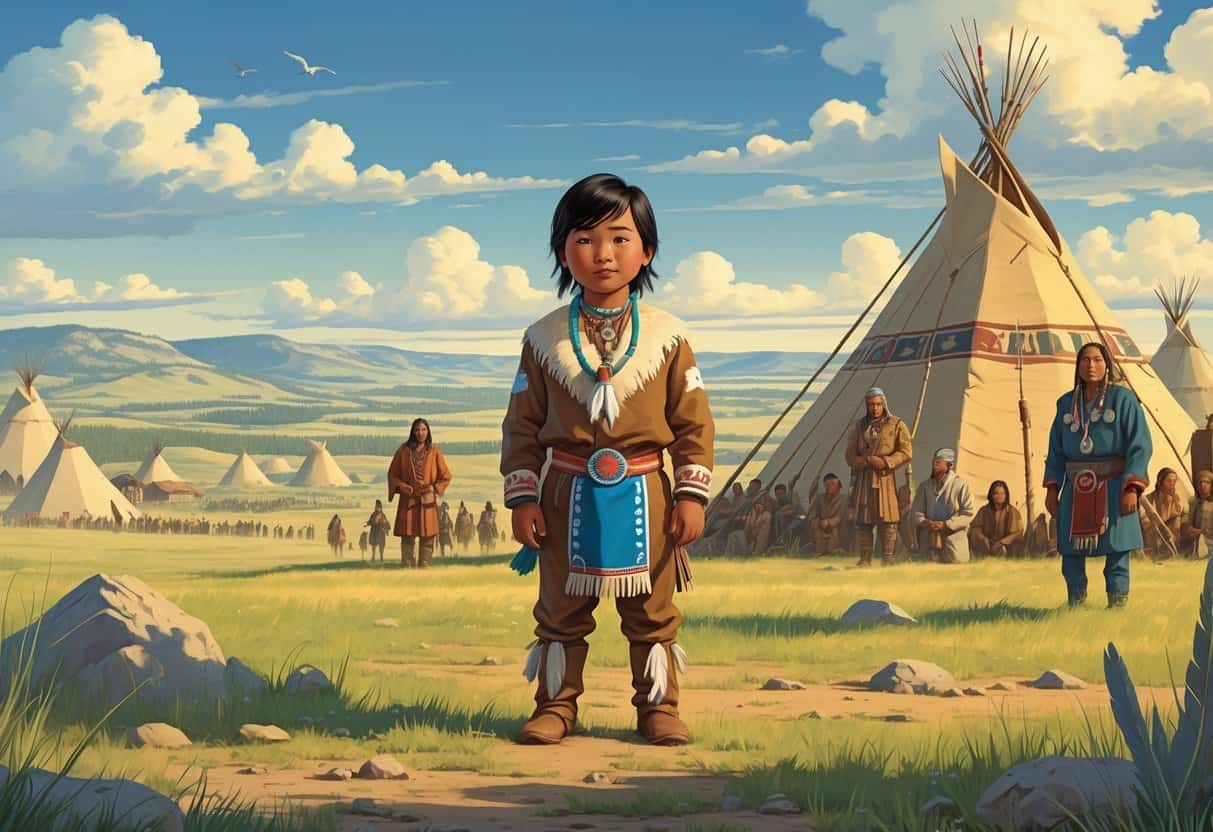Sitting Bull played a key role in Native American history as a leader who fought to protect his people and their way of life. He was a respected chief and medicine man of the Hunkpapa Lakota tribe.

His courage and skill in battle earned him a place in history, especially during events like the Battle of Little Bighorn. Sitting Bull’s story is important for understanding the struggles and resilience of Native American tribes in the 19th century.
Exploring his life gives you a clearer picture of the challenges faced by Native Americans. His actions influenced Native American history and his legacy continues to be remembered today.
Key Takeways
- Sitting Bull was a powerful leader who defended his tribe’s land and culture.
- He played a major role in battles that shaped Native American resistance.
- His legacy remains an important part of Native American and U.S. history.
Sitting Bull’s Early Life and Rise to Leadership

Let’s take a look at Sitting Bull’s background, his early skills as a warrior, and how he grew into a key spiritual guide for the Lakota Sioux Nation. Each part of his story shows how he became such a strong leader, known for courage and wisdom.
Childhood and Cultural Background
Sitting Bull was born in 1831 near the Grand River, in what’s now South Dakota. He belonged to the Lakota Sioux Nation, specifically the Hunkpapa band.
From a young age, he was surrounded by Lakota traditions that shaped his values. He learned about bravery, respect for nature, and loyalty.
His family encouraged these traits. Stories about past warriors and spiritual leaders helped him understand his place in the tribe.
His early life set him up to face challenges with strength and honor. It’s hard not to wonder how much those early lessons stuck with him.
Becoming a Lakota Warrior
As a young man, Sitting Bull proved himself as a brave warrior. He showed his skill in battles that defended Lakota lands from enemies.
His courage earned respect from other warriors. He was known for taking risks to protect his people and their way of life.
His strength wasn’t just physical—it came from deep commitment to his tribe. Each victory brought him more influence among the Lakota Sioux.
Emergence as a Spiritual Leader
Sitting Bull’s role grew beyond fighting. People looked to him for guidance in spiritual matters.
He gained respect as a holy man who could see visions. That reputation gave him real authority when decisions had to be made.
His spiritual insight helped the Lakota Sioux face threats to their land and culture. It also inspired unity and hope during tough times.
Leadership During Conflict and Resistance
Sitting Bull guided his people through fierce battles and tough decisions. His visions shaped strategy, he worked with other leaders, and he faced the U.S. Army during key moments in Native American history.
Battle of the Little Bighorn
At the Battle of the Little Bighorn in 1876, Sitting Bull played a crucial role as a spiritual and political leader. His vision helped unite the Lakota, Cheyenne, and Arapaho tribes against the Seventh Cavalry, led by General George Custer.
This battle is often called Custer’s Last Stand because Native American forces decisively defeated Custer’s troops. Sitting Bull’s leadership inspired warriors like Crazy Horse to fight fiercely, defending the Great Plains and their way of life.
The victory halted U.S. Army advances for a while and showed the strength of the Native alliance against forced removal and broken treaties, especially those involving the Black Hills.
Visions and Strategic Decisions
Sitting Bull was known as a medicine man who used visions to guide choices. Before battles, he’d meditate and share dreams, believing they held messages for victory or danger.
These visions actually influenced the timing and tactics in resisting the U.S. Army. His foresight helped avoid premature attacks and shaped how warriors gathered or spread out.
His spiritual role gave him respect and authority among the tribes. His decisions balanced bravery with planning to protect his people and land.
Relations with Other Native American Leaders
Sitting Bull worked closely with leaders like Crazy Horse and chiefs from the Cheyenne and Arapaho tribes. Together, they formed a strong coalition against U.S. government policies.
You’d see mutual respect and shared goals in their relationships. Sitting Bull’s influence stretched beyond his own tribe.
His ability to unite different groups was key. While each leader had a unique style, Sitting Bull’s vision and steady stance helped coordinate their efforts.
Confrontations with the U.S. Army
Sitting Bull repeatedly faced the U.S. Army as they tried to force Native Americans onto reservations. Tensions rose after treaties like the Fort Laramie Treaty were broken when settlers moved into sacred areas like the Black Hills.
He resisted by refusing to sign away land or accept relocation. His leadership made him a target for the U.S. forces.
Despite the army’s efforts, including campaigns by figures like George Armstrong Custer, Sitting Bull’s people stayed united for years. These confrontations were about survival, culture, and rights to their homeland, with Sitting Bull as a symbol of opposition to U.S. expansion.
Sitting Bull’s Legacy and Cultural Significance
Sitting Bull’s life impacted his people and American history deeply. His influence can be seen in Native resistance, his actions on the reservation, his death, and the shaping of Native identity.
Role in the Ghost Dance Movement
The Ghost Dance was a spiritual movement that promised hope and renewal for many Native Americans. Sitting Bull was cautious about it but respected its growing power.
He was arrested by Indian agents who feared the Ghost Dance could cause trouble. On December 15, 1890, during an attempted arrest, Sitting Bull was killed.
Though he did not lead the Ghost Dance, his connection to it shows how his presence influenced Native spiritual resistance against U.S. control.
Life on Standing Rock and Reservation Challenges
After years of fighting, Sitting Bull settled at Standing Rock Reservation. Life there was tough due to limited resources and strict control by Indian agents.
The Great Sioux Reservation was much smaller than traditional Lakota lands. Many struggled for food, freedom, and cultural survival.
Sitting Bull resisted reservation life as much as possible, trying to keep Lakota traditions alive despite government pressure.
Death and Aftermath
Sitting Bull’s death marked a tragic moment in Native history. His killing led to more fear and anger among Native Americans.
Soon after, the massacre at Wounded Knee Creek happened, where hundreds of Lakota were killed by U.S. troops. This event showed how hostile relations worsened after Sitting Bull’s death.
His death stands as a symbol of Native resistance crushed by force—but also the start of new struggles for rights and recognition.
Impact on Native American Identity
Sitting Bull remains a symbol of pride and resistance for many Native Americans. His story is remembered in community teachings, museums, and cultural events.
He showed how to stand firm for your beliefs and culture. His legacy helps shape Native American identity by inspiring respect for tradition and resistance to unfair treatment.
Many see him as a hero who fought to protect his people’s land, rights, and way of life. His story continues to teach lessons about courage and leadership.
Sitting Bull in American Memory
Sitting Bull’s story is tied to moments where he interacted with expanding American forces and popular culture. His experiences include performing in shows and dealing with railroad expansion.
Buffalo Bill’s Wild West Show Participation
Sitting Bull joined Buffalo Bill’s Wild West Show in 1885 for a short time. The show toured the United States and Europe, showcasing Native American culture and battles reenacted for audiences.
His participation brought attention to his leadership and the struggle of the Lakota people. While the show was entertainment, Sitting Bull used it to keep some control over how his story was told.
This event linked Native American history with popular culture. It was one of the first ways many Americans saw Native leaders, though it often simplified and dramatized the deeper realities of Native life.
Interactions with the Northern Pacific Railroad
The Northern Pacific Railroad played a big role in changing Native lands during Sitting Bull’s life. His fight included opposing railroad expansion through sacred Lakota territory.
Railroads brought settlers and soldiers, disrupting traditional ways and increasing conflict. Sitting Bull’s resistance to these changes was part of his effort to protect his people.
The railroad also represented the U.S. government’s push to open land for development. That tension is still felt in the history of Native American resistance.
Imprisonment at Fort Buford and Fort Yates
After surrendering in 1881, Sitting Bull was held at Fort Buford and later Fort Yates in North Dakota.
These military forts weren’t just buildings—they were places where the U.S. government kept a close eye on him and his followers.
Imagine being a respected leader but living every day under someone else’s watch.
He couldn’t fully lead his people, no matter his reputation or intentions.
At the forts, Sitting Bull faced constant pressure to accept U.S. authority.
This clashed with his identity as a defender of Lakota culture.
His time in captivity ended up shaping how people remember his story in American history.
